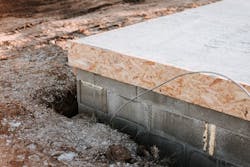Overall construction spending grew in June when compared to both May and June 2020, but gains in residential were offset by sharp declines in nonresidential spending. Total spending for the month was $1.55 trillion, up 0.1 percent from May and 8.2 percent over June 2020.
According to analyses of federal construction spending data by the Associated General Contractors of America and the Associated Builders and Contractors, spending on nonresidential construction declined 0.9 percent over May and 6.6 percent over June 2020. Residential spending climbed 1.1 percent compared to May and 28.8 percent compared to June 2020.
“The pandemic has created a tale of two construction industries, a residential market where demand continues to surge and a nonresidential market that is struggling to gain traction,” said Stephen E. Sandherr, AGC’s CEO, in a prepared statement.
ABC said spending was down on a monthly basis in eight of 16 nonresidential subcategories. Private nonresidential construction spending fell 0.7 percent, and public nonresidential construction spending fell 1.2 percent in June compared to May. Year-over-year spending was down in 15 categories. Private nonresidential construction spending has declined 6 percent since June 2020, and public spending is down 7.6 percent.
According to AGC, the largest private nonresidential category, power construction, fell 1.9 percent year-over-year and 1.2 percent from May to June. Among the other large private nonresidential project types, commercial construction—comprising retail, warehouse and farm structures—retreated 2.1 percent year-over-year and 0.2 percent for the month. Manufacturing construction fell 0.7 percent from a year earlier and 1.1 percent from May. Office construction decreased 9.1 percent year-over-year and by 0.1 percent compared to May.
Among the largest public nonresidential segments, highway and street construction declined 7.6 percent from a year earlier and 5.3 percent compared to May 2021, according to AGC. Public educational construction decreased 9.1 percent year-over-year and 0.8 percent in June. Spending on transportation facilities fell 5.7 percent over 12 months but was up 1.1 percent in June.
“Since achieving an all-time high in January 2020, nonresidential construction spending is down 12 percent,” said ABC chief economist Anirban Basu in a statement. “For economists, this presents a bit of a paradox. Many contractors report rising backlog and strong expectations for sales, staffing and profit margin growth over the balance of the year, according to ABC’s Construction Backlog Indicator and Construction Confidence Index.
“But this lofty demand is failing to translate into construction spending growth because available capacity to supply services is so constrained, especially by expanding skills shortages,” Basu said. “This means the average project is taking longer to complete. It also translates into diminished construction spending on a monthly basis since less services are delivered. Consequently, individual firms generally remain confident about the future given the presence of demand for their services as well as rising backlog, but the macroeconomic outcomes remain uninspiring as quantity supplied struggles to match quantity demanded.”




